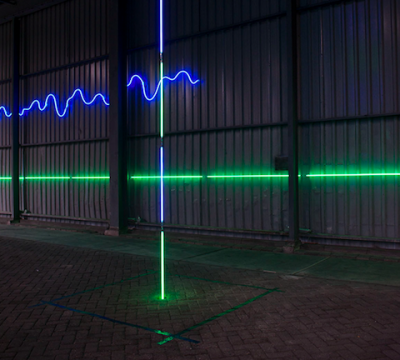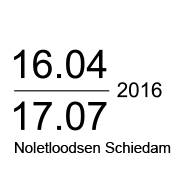jan van munster
Energy is a phenomenon that Jan van Munster (Gorinchem, 1939) has been investigating since 1970. Temperature, magnetism, radioactivity and electricity form the basis for many works, through which he makes the invisible visible. Not only the physical processes, but also the less tangible aspects of energy, such as vitality and creativity capture his interest.
His work is always recognisable, despite the great variety in his use of materials: austere formations of filaments, neon lights on buildings, an orb of ice on a table. Everything has been perfected and reduced to its essence.
Jan van Munster studied at the Academy of Visual Arts in Rotterdam and the Institute for Craft Education in Amsterdam. His work can be seen in many locations, both nationally and internationally, and has been made a part of several international collections. He is the founder and creator of the concept of Stichting IK.
Who’s afraid of blue and green?
He’s one of those rare artists who is genuine in his generosity toward fellow artists. A conversation with minimalist Jan van Munster (1939) is therefore also always about the work of colleagues. Age is of no concern to him. No more than the visual jargon. Van Munster marvels at the fiercely sculpting and painting, relatively young David Bade, for example. But just as passionately, he loves the tenuous, abstract works weaved into space with cotton threads by American minimalist Fred Sandback, who died in 2003.
In terms of his own work, Van Munster has more in common with Sandback than with Bade. But the quality strived after by the two is the same. For take a look at an individual work by Bade: it appears to resemble a stew, wildly assembled. And yet Van Munster recognises the unity, a calculated aesthetic and a vitality that appeal to him. Those contradictions, that recalcitrance is what he always tries to bring back in his own work. ‘I’m looking for short-circuits,’ he says. Short-circuiting never leads to figuration with him. As a Dutchman, he likes flat and straight. Mondriaan is in his veins. He finds mountains ‘kitsch’. ‘I’m always relieved once I’ve crossed the Alps and I drive into the Po Plain.’ Energy is the basis around which everything revolves, which everything can be traced back to. Magnetic forces, germinative power, light, the energy of heat and cold, the force fields between you and me. This may sound floaty, but Van Munster’s work is anything but.
Over the past decades, in and around The Netherlands, abstract, minimalist works have appeared in public spaces, museums, by motorways and buildings. You’ve probably seen one. The works are solid as a rock, but somehow appear as though they might be blown away with a single breath. That’s how fragile they seem. This is due to the fact that Van Munster’s work often consists of only a single line. Sometimes that line undulates, at times she shoots diagonally upward like an arrow, at times she forms a circle. The lines light up in colour: they are — just like the work here at the Noletloodsen — built up of neon tubes. The colours, the clear lines give the work its remarkably pictorial and aesthetic quality.
BRAINWAVE (Ratio) (2016) is another one of those gigantic yet tenuous works of light art, consisting (clearly) of three parts: a seemingly malleable, blue jagged line of neon light, a straight line in green and a vertical blue-green line. In total, the work spans forty metres in length and seven metres in hight. I look from left to right and see a shudder which is interrupted, yet already continued — a little lower — in a fixed green line. On the right, diagonally in front of the green line stands a line reaching for the heavens but simultaneously firmly rooted in the earth. BRAINWAVE (Ratio) is therefore not just a wall sculpture, the work takes a place within the space.
The shuddering line is recurrent in Van Munster’s work. In 1995 the artist had an EEG done, not because he was sick, but out of curiosity, out of a need to see what such an EEG might do for his art. Twenty-four electrodes are attached to his head. The programme of demands he presents to the doctor (make me angry, hit me, turn me on, be gentle) is rigorously referred to the bin. Van Munster has to undergo other tests. He is artificially made to hyperventilate, lulled to sleep and much more. A thick book consisting of hundreds of pages of jagged lines is the result: a goldmine for the artist. Still he draws from the electrical currents emitted by his brain over twenty years ago.
The frenzy of the ‘brainwave’ in BRAINWAVE (Ratio) formally finds its antipole in the serenity of the straight line, and in that primal symbol of the western world: the cross. Naturally that gives the work an extra quality. Van Munster not only portrays the battle between emotion and ratio, but also that between the metaphysical light and darkness, between life and death, heaven and earth. The language in which he portrays this dimension is abstract. However, that does not make Van Munster an abstract artist. Van Munster uses seemingly minimal means to evoke massive emotions. And in such a way that it makes one wonder: am I afraid of this blue and green, or might I love it instead?


